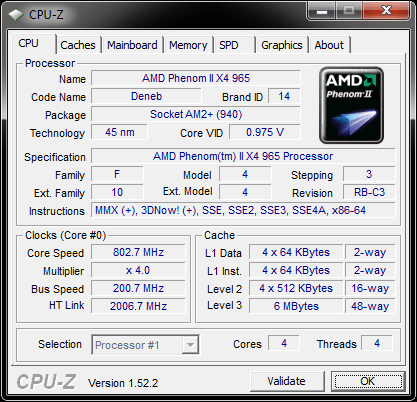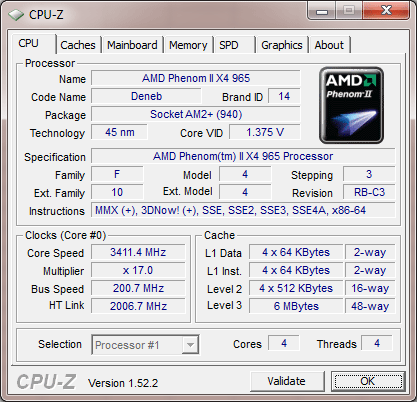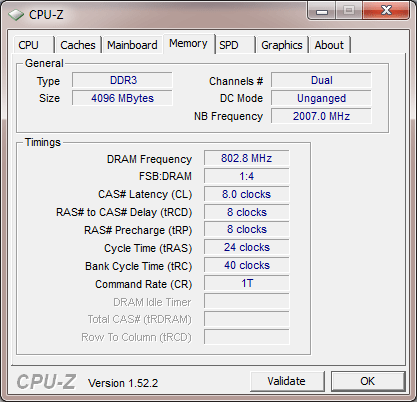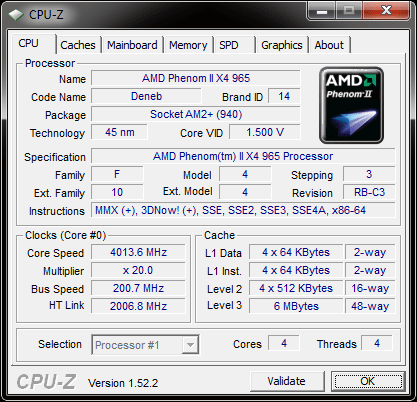Magasröptű gondolatoktól valamint "kékzoknit vettem fel ma reggel" jellegű posztoktól mentes jegyzettömb jellegű karakteres alapú tárhely szigorúan saját részre.
Notepad - Logoszféra fórum
hozzászólások
Windows 7 és SSD, két jó barát
"A korábbi ígéretekhez híven megérkezett az Intel notebook SSD-khez az új firmware, mely már lehetővé teszi a Windows 7 számára a meghajtó optimális kiaknázását. A hasonló előnyök elérése érdekében az Intel szoftveres támogatást ad a korábbi Windowsokhoz."
...és az optimális kiaknázás:
Intel pulls SSD Toolbox for killing drives under Windows 7
[ Szerkesztve ]
AMD ATI Chips Comparison Table (9200-tól)
nVidia Chips Comparison Table (GF4 MX 420-tól)
The Golden Era of 3D Acceleration - 1994 / 2003
Érdemes megnézni.
Úgy fest hogy egy kissé elsiették a publikálását. (NDA)
Ez megmaradt a Firefox-ban:
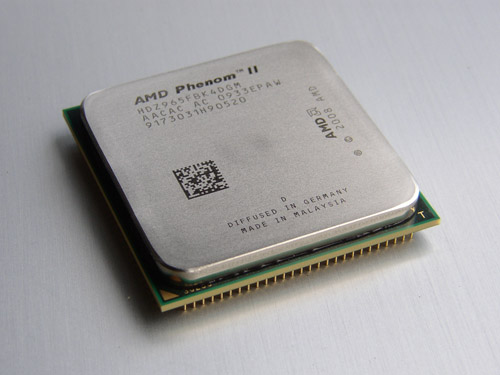
The C3 Revision
Just like its predecessor, the new Phenom II X4 965 BE runs at 3.4GHz, likewise, there are no changes in the cache architecture. Note, however, the new stepping (3) and the new revision code (RB-C3).
Idle State
Exactly like the older version, the new '965 BE C3" throttles back to a 4 x multiplier for an 800 MHz core clock if there is no load on the CPU.
North Bridge
At default setting, the NB is running at 2.0GHz.
Overclocking
Whereas we had to resolve to somewhat arctic temperatures to squeeze 3.8GHz stable operation out of the previous revision, the C3 revision manages 4GHz at only a minor core voltage increase and air cooling at ambient room temperature.
We were able to get into Win7 at 4.1 GHz but it would be exaggerating to claim stability at that speed. At 4.2 GHz, the CPU still reached the Windows7 desktop but crashed. Bear in mind that all of this was achieved using standard air cooling.
On the NB side of things, 3.0 GHz was also a breeze, and we achieved a score of 16783 in the multithreaded benchmark of Cinebench R10 (4.0GHz/3.0Ghz; 32 -bit binaries in Win7 64).
SATA 6G 6.0 Gb/s Performance Preview - Seagate XT drive tested
Remélem hogy idővel lesz belőle 1TB-os verzió is.
DDR
DDR400 CL3: 1000/200 = 5 -> 15,0 ns ciklusidő
DDR400 CL2,5: 1000/200 = 5 -> 12,5 ns ciklusidő
DDR400 CL2: 1000/200 = 5 -> 10,0 ns ciklusidő
DDR500 CL2,5: 1000/250 = 4 -> 10,0 ns ciklusidő
DDR500 CL2: 1000/250 = 4 -> 8,0 ns ciklusidő
DDR550 CL2: 1000/275 = 4 -> 7,272 ns ciklusidő
DDR600 CL2,5: 1000/300 = 3,33 -> 8,325 ns ciklusidő
DDR600 CL3: 1000/300 = 3,33 -> 9,99 ns ciklusidő
DDR2
DDR2-667 CL5: 1000/333 = 3 -> 15,0 ns ciklusidő
DDR2-667 CL4: 1000/333 = 3 -> 12,0 ns ciklusidő
DDR2-800 CL5: 1000/400 = 2,5 -> 12,5 ns ciklusidő
DDR2-800 CL4: 1000/400 = 2,5 -> 10,0 ns ciklusidő
DDR2-1066 CL5: 1000/533 = 1,87 -> 9,38 ns ciklusidő
DDR2-1066 CL4: 1000/533 = 1,87 -> 7,5 ns ciklusidő
DDR2-1200 CL5: 1000/600 = 1,66 -> 8,3 ns ciklusidő
DDR2-1200 CL4: 1000/600 = 1,66 -> 6,64 ns ciklusidő
DDR3
DDR3-1066 CL6: 1000/533 = 1,87 -> 11,22 ns ciklusidő
DDR3-1066 CL7: 1000/533 = 1,87 -> 13,1 ns ciklusidő
DDR3-1333 CL5: 1000/666 = 1,50 -> 7,5 ns ciklusidő
DDR3-1333 CL6: 1000/666 = 1,50 -> 9,0 ns ciklusidő
DDR3-1333 CL7: 1000/666 = 1,50 -> 10,5 ns ciklusidő
DDR3-1600 CL6: 1000/800 = 1,25 -> 7,5 ns ciklusidő
DDR3-1600 CL7: 1000/800 = 1,25 -> 8,75 ns ciklusidő
DDR3-1600 CL8: 1000/800 = 1,25 -> 10,0 ns ciklusidő
DDR3-1866 CL6: 1000/933 = 1,07 -> 6,42 ns ciklusidő
DDR3-1866 CL7: 1000/933 = 1,07 -> 7,49 ns ciklusidő
DDR3-1866 CL8: 1000/933 = 1,07 -> 8,56 ns ciklusidő
DDR3-2000 CL7: 1000/1000 = 1,00 -> 7,00 ns ciklusidő
DDR3-2000 CL8: 1000/1000 = 1,00 -> 8,00 ns ciklusidő
DDR3-2000 CL9: 1000/1000 = 1,00 -> 9,00 ns ciklusidő
DDR4
DDR4-2133 CL14: 1000/1066 = 0,94 -> 13,16 ns ciklusidő
DDR4-2133 CL15: 1000/1066 = 0,94 -> 14,10 ns ciklusidő
DDR4-2133 CL16: 1000/1066 = 0,94 -> 15,04 ns ciklusidő
DDR4-2400 CL15: 1000/1200 = 0,83 -> 12,45 ns ciklusidő
DDR4-2400 CL16: 1000/1200 = 0,83 -> 13,28 ns ciklusidő
DDR4-2400 CL17: 1000/1200 = 0,83 -> 14,11 ns ciklusidő
DDR4-2400 CL18: 1000/1200 = 0,83 -> 14,94 ns ciklusidő
DDR4-2666 CL17: 1000/1333 = 0,75 -> 12,75 ns ciklusidő
DDR4-2666 CL18: 1000/1333 = 0,75 -> 13,50 ns ciklusidő
DDR4-2666 CL19: 1000/1333 = 0,75 -> 14,25 ns ciklusidő
DDR4-2666 CL20: 1000/1333 = 0,75 -> 15,00 ns ciklusidő
DDR4-2933 CL19: 1000/1467 = 0,68 -> 12,92 ns ciklusidő
DDR4-2933 CL20: 1000/1467 = 0,68 -> 13,60 ns ciklusidő
DDR4-2933 CL21: 1000/1467 = 0,68 -> 14,28 ns ciklusidő
DDR4-2933 CL22: 1000/1467 = 0,68 -> 14,93 ns ciklusidő
DDR4-3200 CL20: 1000/1600 = 0,63 -> 12,60 ns ciklusidő
DDR4-3200 CL22: 1000/1600 = 0,63 -> 13,86 ns ciklusidő
DDR4-3200 CL24: 1000/1600 = 0,63 -> 15,12 ns ciklusidő
DDR4-3200 CL14: 1000/1600 = 0,63 -> 8,82 ns ciklusidő
DDR4-3200 CL15: 1000/1600 = 0,63 -> 9,45 ns ciklusidő
DDR4-3200 CL16: 1000/1600 = 0,63 -> 10,08 ns ciklusidő
DDR4-3733 CL16: 1000/1867 = 0,59 -> 8,57 ns ciklusidő
DDR4-3733 CL17: 1000/1867 = 0,59 -> 9,10 ns ciklusidő
DDR4-4000 CL15: 1000/2000 = 0,50 -> 7,50 ns ciklusidő
DDR4-4000 CL16: 1000/2000 = 0,50 -> 8,00 ns ciklusidő
DDR4-4000 CL17: 1000/2000 = 0,50 -> 8,50 ns ciklusidő
DDR4-4000 CL18: 1000/2000 = 0,50 -> 9,00 ns ciklusidő
DDR4-4133 CL16: 1000/2066 = 0,48 -> 7,74 ns ciklusidő
DDR4-4266 CL16: 1000/2133 = 0,47 -> 7,50 ns ciklusidő
[ Szerkesztve ]
VIA Introduces New VIA Nano 3000 Series Processors
"With a host of advanced features including 64-bit support, advanced CPU virtualization technology, SSE4 for enhanced multimedia processing, and the industry-leading encryption and security capabilities integrated in the VIA PadLock Security Engine, VIA Nano 3000 Series processors also provide a secure, high-performance solution for emerging cloud-based computing environments."
Az ION-nal majd egész jó kis kombó lehet.
[ Szerkesztve ]
John Fruehe - Director of Business Development for Server/Workstation AMD:
You are mistaken about TDP, because both companies deal with it differently.
Intel has 2 power levels: TDP and max power, (and now a third, "sustained power").
Take a look at the X5570 to see: [link]
Maximum power dissipation (W) 197.97; 155.56 (sustained)
Thermal Design Power (W) 95
So the way Intel always measured it in the past, Max power is the maximum power that a CPU can draw. Every transistor firing in a worst case scenario.
TDP is a de-rated value (used to be 80%, but it has been creeping down which is bad). Intel would take the maximum power, assume that the processor would throttle the clock down and then take that measurement (of a throttled processor) as the "TDP".
Since that time they have added a maximum sustained, maybe you can ask them what that means. I am assuming that max power is a spike power and that sustained is something that lasts more than a few milliseconds.
Regardless, the maximum power that the processor could conceivably draw is 197W.
Our TDP is equivalent to their max power, it is the maximum power the processor could draw, every transistor firing in a worst case scenario.
Our ACP is average CPU power. We run standard workloads, run them at 100% utilization and measure power.
Intel is not real open about max power. They used to post it online, but when they started getting pressure from AMD about those max power ratings, they stopped showing up online.
I'd love to have someone from Intel come here to debate this topic, because at this point, the specs (which they try to keep private) are not in their favor.
In designing a system to max power (which you have to do), we are not 42w disavantaged, we are actually 60w advantaged.
We do release max power. It is called TDP.
The reason the thermal design sheet lists TDP is because that is what you use to design systems. TDP is designed for system builders and OEMs. ACP is designed for customers in figuring out what they need for the data center.
ACP came into being a few years back because our TDP was 95W and it was rare that we ever had a part that even got above 50W. Customers were complaining that they were budgeting their racks for a certian amount of power, assuming 95W, and then ending up heavily under utilized. We were getting a lot of complaints from customers that we were too conservative and that this was leading to too much inefficiency in their data centers. I was on the receiving end of a lot of these conversations and they were not pleasant as data center floor space was the most expensive real estate in the building.
If you want a simple rule of thumb, use the following.
Most power a system can draw:
Intel = Max power
AMD = TDP
Typical power draw for standard applications:
Intel = TDP
AMD = ACP
If you are asking "why doesn't AMD just use TDP like the rest of the world" then you are on to something. We actually do. If you bother to go back to the wikipedia link above, you'll see TDP defined as:
"The thermal design power (TDP), sometimes called thermal design point, represents the maximum amount of power the cooling system in a computer is required to dissipate"
That sounds a lot like how AMD defines TDP, but that also sounds like how Intel defines max power. So, in reality, the "hoky" measurement is actually Intel's TDP because it does not represent what the rest of the industry means when they say TDP.
Cuomo Files Federal Antitrust Suit Against Intel
For example, Intel is accused of paying I.B.M. $130 million to hold back on selling a server based on A.M.D.’s Opteron chip, while also threatening to curtail joint projects if I.B.M. marketed A.M.D.’s products. “The question is, can we afford to accept the wrath of Intel?” an I.B.M. executive wrote in a 2005 e-mail message, according to Mr. Cuomo’s office.
A similar e-mail message from an unnamed Hewlett-Packard executive talks about Intel planning to “punish” the company for selling products based on A.M.D.’s chips.







